
 |
Home | Tibet Buddhism Main | Contact |
Updated: February 2009
The following reference information is included:
My rating scale:
 Excellent ;
Excellent ;
 Very Good ;
Very Good ;
 Good ;
Good ;
 Fair ;
Fair ;
 Poor.
Poor.
Click on an image to see the FULL size with a caption.
I would much prefer studying Buddhism through books than DVDs, but I found these ones quite good.
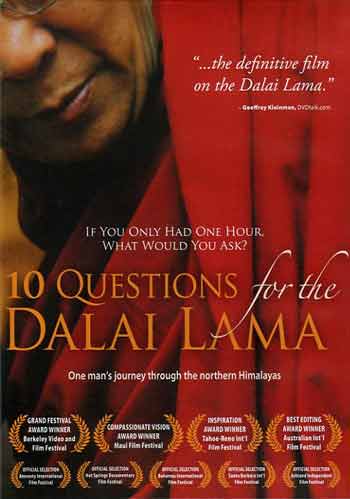
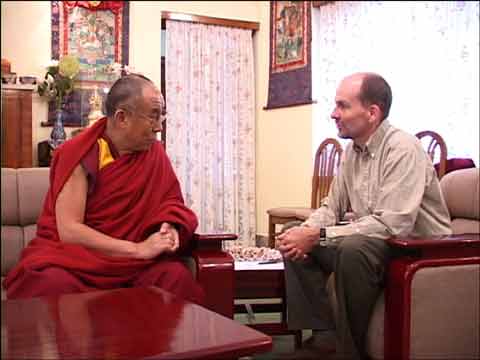

By Rick Ray. Released 2006. 85 minutes. Rick Ray describes the film perfectly in one of the bonus features: "... a tapestry of my personal journey, my thinking of the questions, his biography, the Tibetan struggle, and then his answers all woven together into one story."
After traveling around India, including visiting Ladakh where Tibetan culture and lifestyle still flourish, Rick Ray visits the Dalai Lama's monastery in Dharamsala. He interviews the Dalai Lama's secretary and then has an hour with the Dalai Lama. Among the 10 questions, he asks the Dalai Lama about why the poor often seem happier than the rich, about Tibetan traditions and culture, and the China issue. Often laughing aloud, the Dalai Lama answers the questions with simple, yet profound, insight. Ray intersperses film footage with the answers.
Rick Ray shows lots of rare archival footage that he was able to find, including the young Dalai Lama in 1939, the Chinese invasion, the Dalai Lama after he fled to India, and his acceptance speach for the Nobel Peace Prize. The modern footage of Lhasa shows kids on go-carts across from the Potala Palace, the ever increasing number of Chinese, and the ever present security cameras, resulting in what the Lama refers to as a "cultural genocide."
Bonus features are a 19-minute interview with Rick Ray, a 52-minute interview with the Dalai Lama's secretary Tenzin Geyche Tethong, and 17 minutes of six deleted scenes.
I highly recommend this film as a basic overview of the Dalai Lama and his philosophy, and the Tibetan issues. If you are looking for in depth analysis, this is not the film for you. The film could have been a bit tighter if some of the Indian travel was moved to the deleted scenes. I especially enjoyed seeing the Dalai Lama's playful side, where he doesn't pay attention at long pageants and celebrations, and dashes delightfully into the crowd that had gathered to watch a religious procession because he recognized someone there. The soundtrack by Peter Kater is very good, with beautiful piano playing with occasional flute and chanting.
Two Dalai Lama quotes I really liked are: "Destruction of your enemy is also destruction of yourself." In the U.S.: "I don't admire your weapons. I admire your principles: democracy, liberty, freedom."

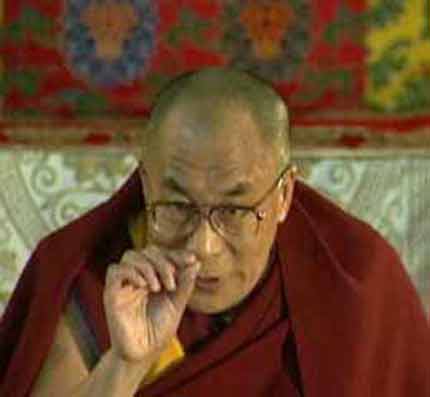

Released 2006. 214 minutes. Contains three historic talks by the Dalai Lama:
1. Meditating With The Dalai Lama (51 minutes, Dharamsala March 1995) is a clear introduction to the nature and benefits of meditation. In a fun and easy going way, the Dalai Lama shows how to meditate and obtain mental happiness. This is the first step on the path to improving our capacity for joy, compassion and happiness.
2. The Power Of Compassion (61 minutes, UK 1993) encourages us to forget our differences and focus on how we are fundamentally the same. So begins the path of compassion. Compassionate people are happier, calmer and healthier and create a pleasant environment for the family and community.
3. Compassion: The Basis Of Human Happiness (102 minutes, Manchester Free Trade Hall, UK July 19, 1996) goes into greater detail of how cultivating compassion for ourselves and others creates happiness. This allows us to be more sincere in our lives and allows others to do the same.
I really like the Dalai Lama in person. He is gregarious, funny and sincere. His teachings are simple and to the point.
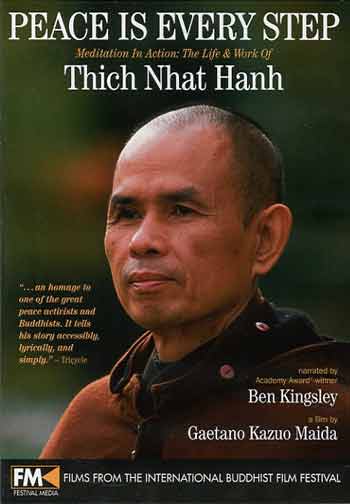
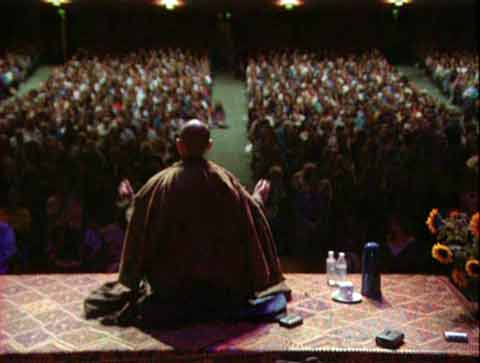

The DVD contains two features directed by Gaetano Kazuo Maida. Thich Nhat Hanh's biography is narrated by Ben Kingsley, is 52 minutes long, and was released in 1998. Touching Peace is a public talk from Berkeley, is 85 minutes long, and was released in 1993.
The biography documents Thich Nhat Hanh's life starting as a boy and features lots of archival footage from Vietnam, including films of Chan Khong as one of the first six members of the Order of Interbeing. More recent footage include talks with Vietnam veterans and visiting the Vietnam Veterans Memorial in Washington and Plum Village in France. There are interviews with Chan Khong and U.S. Vietnam veterans like Claude Thomas, now a Zen priest.
"The miracle is not to walk on water. The miracle is to walk on the green earth in the present moment, to appreciate the peace and beauty that are available now."
The public talk begins with a brief introduction by Joanna Macy. Thich Nhat Hanh then talks to the audience about many of his core teachings, including interbeing, mindfulness, the seeds passed to you by your parents and ancestors, flower watering, meditation, habit energy, and being there for your loved ones. The film closes with a beautiful song by Vietnamese nun Chan Khong.
The documentary was interesting, especially the archival footage. However, the reason to buy this DVD is the public talk, which provides a surprisingly detailed summary of Thich Nhat Hanh's main teachings in a clear, calm and concise manner.
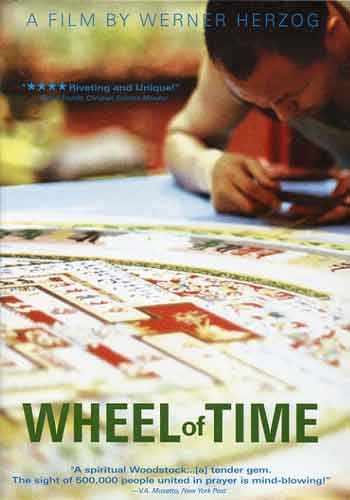
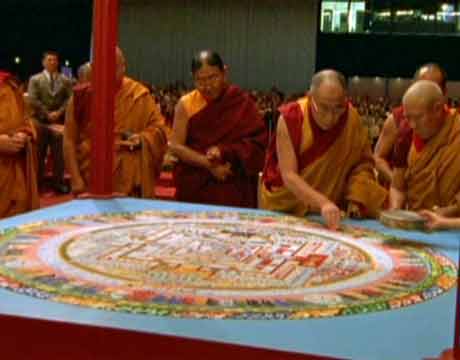
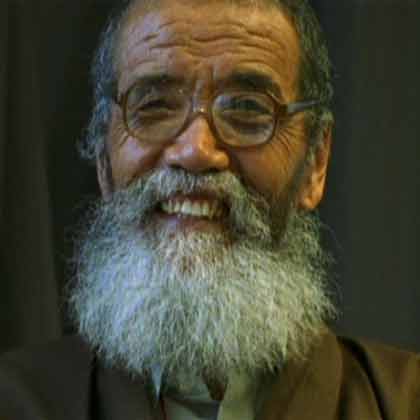

Directed, written, and narrated by Werner Herzog. Released 2003. 80 minutes. A documentary in three parts: the Kalachakra Mandala Initiation in January 2002 for 500,000 pilgrims and monks at Bodh Gaya, India where the Buddha attained enlightenment; a visit to the Saga Dawa festival at Mount Kailash in Tibet; and the Kalachakra Mandala Initiation for 8,000 people at Graz, Austria in October 2002.
The Bodh Gaya initiation was postponed to 2003 because the Dalai Lama was sick. The film shows the grounds of Bodh Gaya, the pilgrims and monks, the making of the sand mandala, and the feeding of such a large number of people.
Mount Kailash is perceived to be a mandala by Buddhists, Hindus, and Bons. This portion of the film starts with the pilgrims arriving on open-backed trucks and prostrating when they see Kailash for the first time. It follows the pilgrims to the Saga Dawa festival with the raising of the Tarboche pole. It concludes with the Kailash kora to the north face of Kailash, some of the pilgrims prostrating the whole way.
The Dalai Lama does preside over the Graz Kalachakra initiation. The film shows the monks creating the sand mandala and the Dalai Lama destroying the mandala at the end of the initiation, signifying impermanence. In addition, Mattieu Ricard interviews Takna Jigme Sangpo, an old Tibetan who had just been released by the Chinese after 32 years in prison, mostly for shouting Free Tibet.
I really liked the Kailash and Graz portions of the film - short, tight, and well filmed. I especially liked the interview of Takna Jigme Sangpo - he is so kind, warm-hearted and positive for somebody persecuted by the Chinese for so long. I think the The Bodh Gaya portion of the film was too long, and focuses too much on the background of the initiation. The close ups of the faces of the monks and pilgrims visually tell the story of their devotion.
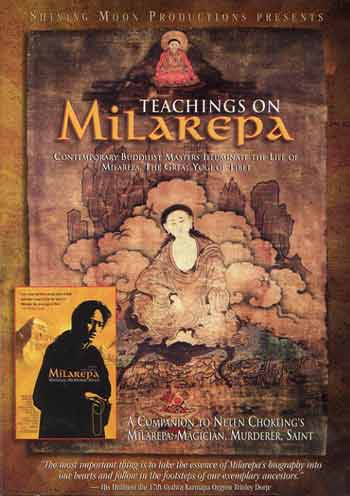
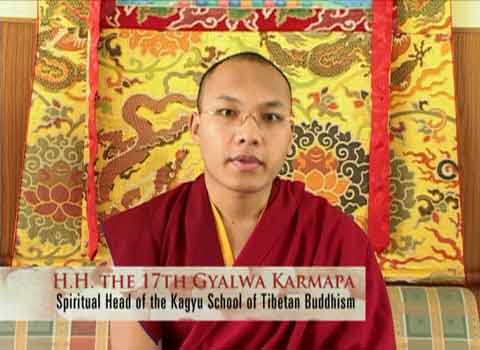

In this 3-hour companion DVD to Milarepa: Magician, Murderer, Saint, 8 Buddhists give commentaries and insights into Milarepa's life and its significance for modern spiritual practitioners. Overall, I think that this video should not have been made. Sogyal Rinpoche, Pema Chodron and director Neten Chokling Rinpoche would have been great extras when the Milarepa movies is released on DVD.
His Holiness the 17th Karmapa (18 minutes) provides an overview of Milarepa's life. I enjoyed seeing the young 17th Karmapa, even though he was pretty boring.
Khandro Rinpoche (46 minutes) teaches on impermanence and renunciation. I enjoyed her teaching - simple yet funny.
Orgyen Tobgyal Rinpoche (29 minutes, starred in The Cup and Milarepa) hopes the movie will make it easier for people to be left with an imprint of Milarepa's story. I thought his comments were basic.
Sogyal Rinpoche (29 minutes) provides the best insight to Milarepa's life and what we can learn from it.
Pema Chodron (18 minutes) provides the most personal impact from Milarepa, remembering that the Milarepa story helped her renounce her previous life.
Lama Zopa Rinpoche (31 minutes) was the most boring of all the pieces, reading from off screen very basic teachings.
Arjia Rinpoche (11 minutes) provides yet another overview of Milarepa's life.
Neten Chokling Rinpoche (12 minutes, director of Milarepa) says that Milarepa shows that enlightement is possible for anybody in one lifetime, and quotes a few of Milarepa's songs.
Here are my favourite Buddhist movies.
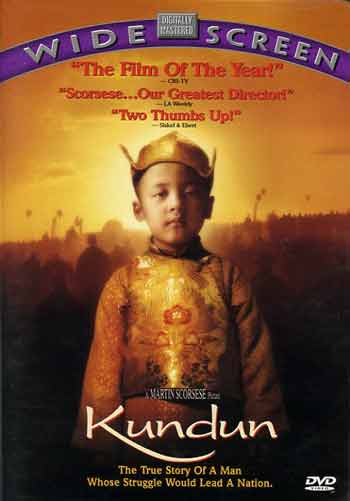
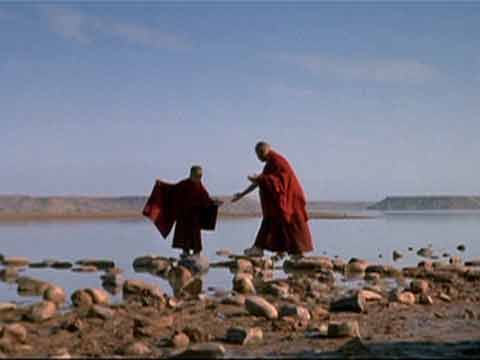

Directed by Martin Scorsese. Starring Tenzin Thuthob Tsarong and Tencho Gyalpo. Released 1997. 134 minutes. Nominated for four Academy Awards. Filmed in Morocco.
This movie tells the life of the current 14th Dalai Lama (known as Kundun in Tibet) from his birth to his escape to India in 1959. It beautifully depicts the culture of Tibet at that time - the devout people and their dress, the monasteries, the sand mandala, and the disturbing scenes with the Nechung Oracle spinning in his trance.
"I was trying to put together a story through images, music, colour and light; a movie that would ultimately reflect emotionally and psychologically, the philosophy of a people and Tibetan culture" - Martin Scorsese.
The story is told through the eyes of the Dali Lama. So we only know as much as the boy knows. Although Tibet is shown as an idyllic land, the film shows that the Dalai Lama recognizes and wants to fix problems as well. He tells Mao, 'I see a lot of ways to change, especially industrialize Tibet'. After the Chinese invasion at the end of the film he says, 'we were just about to change, we were about to do it ourselves'.
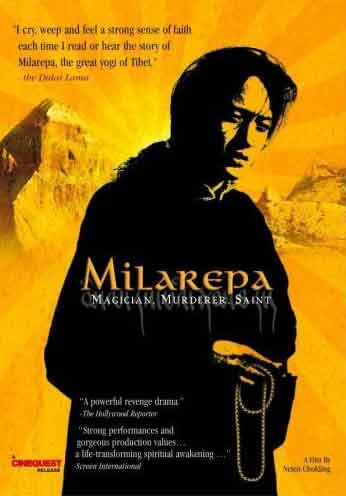


Directed by Neten Chokling, who was an actor in Khyentse Norbu's The Cup. Starring Jamyang Lodro and Orgyen Tobgyal. Released 2006. 90 minutes. Tibetan with English sub-titles. Filmed in the Spiti Valley on the Indian-Tibetan border. This award winning film tells the story of the first half of Milarepa's life (1052-1135), whose path to enlightenment began with revenge. A second movie is planned for 2009 to complete the story.
When his well-to-do merchant father died, Milarepa's uncle and aunt took all the family's wealth, suddenly thrusting Milarepa and his mother into poverty. His mother plots revenge by sending Milarepa away to study sorcery. Milarepa comes back to the village and causes a violent lightning storm to kill many people.
When the villagers chase him, Milarepa causes large rocks to fall from a ridge blocking their way. As he escapes Milarepa meets an old monk, and learns of Buddha's teachings. Milarepa returns to his sorcery teacher, who advises him to study with Marpa. The film ends with Milarepa seeking Marpa.
The landscape is stark and beautiful. The special effects are quite well done - I especially liked the scene where Milarepa gains mastery in sorcery, a bit like a Pink Floyd psychedelic trip from the 60s. My favourite scene was when Milarepa meets an old monk while escaping from the villagers, and sits quietly with old Buddhist paintings all around him on the wall. You can feel that his redemption is at hand.
As a companion to this movie, I highly recommend reading a book about his life such as The Magnificent Trickster - The Story Of Milarepa by Molly MacGregor, and some of his teachings like in the book Milarepa: Songs On The Spot by Nicole Riggs.
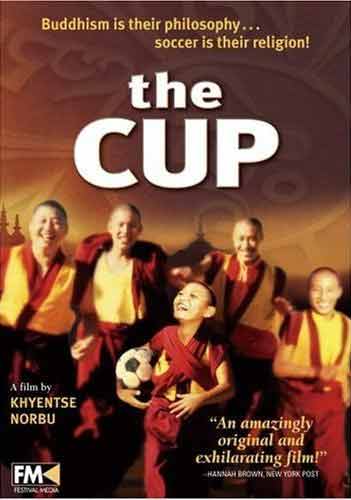
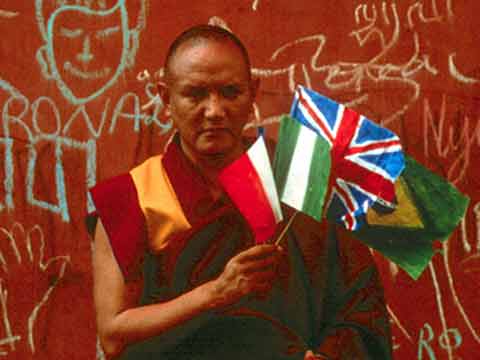

Directed by Khyentse Norbu. Starring Orgyen Tobgyal and Neten Chokling. Released 1999. 93 minutes. Filmed in the north of India.
Set in a Tibetan monastery-in-exile in India, this movie follows a few young monks who sneak out at night and watch football (soccer) games on a b/w TV in a neighboring house. After getting caught the night before the World Cup final match, they beg the Lama to let them rent a TV and satellite dish so they can watch the final game. The task becomes a test of solidarity, resourcefulness and friendship for the students, while the Lama contemplates the challenges of teaching the word of Buddha in a rapidly changing world.
The Cup contrasts the abbot's gentle musings about progress with the young monks' enthusiasm, but avoids being too didactic about its points. The sweet and genuine Tibetan comedy lets you get inside the life of monastery, presenting the daily lives of the monks, with light humour, but without any preaching.
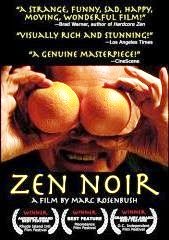
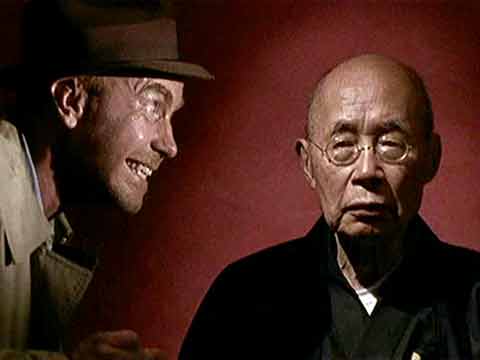

Directed by Marc Rosenbush. Starring Duane Sharp and Kim Chan. Released 2004. 66 minutes. This award winning film follows a detective, still mourning the loss of his wife, as he investigates a mysterious death in a Zen Buddhist temple. The detective struggles with his logical crime-solving questions getting nowhere. One of the monks steals his gun and commits suicide.
The detective falls in love with a female lay person, who gets laid by the detective. With the help of the Zen master, the detective eventually experiences the more intuitive world of Zen, takes up meditation, and learns to deal with the death of his wife, and death in general.
Extras include two director's commentaries - one on the making of the film and the other on the Buddhist ideas behind the film with Brad Warner.
This movie is supposedly a koan on the meaning of life and death. There are some very funny moments, like when the master keeps beating the detective with a rubber bat when he keeps asking logical questions about death. There are also some simple but deep statements like when the detective asks, "What happens when we die?", the master responds, "Don't know. Not dead yet." If you are confused with the ideas in the film, I recommend you watch the director's commentary with Brad Warner, which explains some basics of Zen Buddhism and the teachings of Vietnamese monk Thich Nhat Hanh.

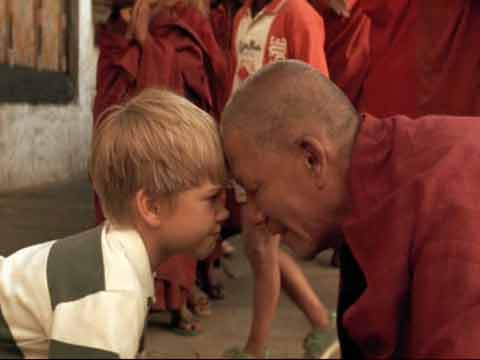

Directed by Bernardo Bertolucci. Starring Ruocheng Ying, Chris Isaak, Bridget Fonda, Keanu Reeves, and Sogyal Rinpoche. Released 1994. 123 minutes. Filmed in Bhutan, Seattle, Kathmandu, and Nepal.
This film weaves two stories together. The first story is the quest of Lama Norbu (Ying Ruocheng) to find the reincarnation of his former teacher, starting in Seattle with a young blond-haired boy named Jesse. After Jesse's Dad suffers through a death, he decides to accompany his son to Bhutan. Two other children from Kathmandu and India are also identified as potential reincarnations, so all three journey to Bhutan where they must undergo a test to prove who is the true reincarnation.
Lama Norbu to the three children: "The most important thing of all is to feel compassion for all beings, to give of oneself and above all, to pass on knowledge like the Buddha."
Interspersed with this story is a history lesson of the life of Siddhartha Gotama, played by Keanu Reeves, tracing his spiritual journey from birth to living richly in his father's palace to his ascetic years and his enlightenment as the Buddha.
The 45-minute Siddhartha part of the movie is superficial with poor wooden acting. I though it distracted from the real story, and I think it should have been cut altogether. The search for Lama Dorje's reincarnation was very good, with especially good acting by Ruocheng Ying as Lama Norbu.
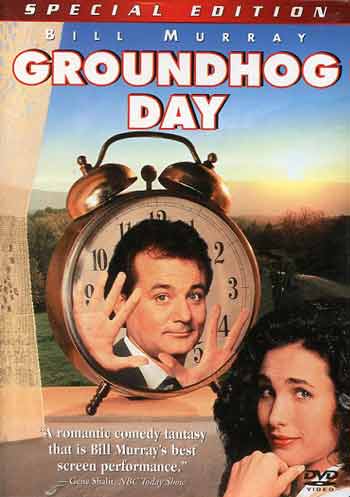
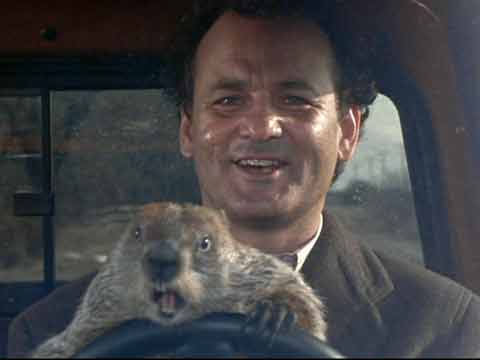

Directed by Harold Ramis. Starring Bill Murray and Andie MacDowell. Released 1993. 101 minutes.
Bill Murray's character wakes up every morning in the exact same place, at the exact same time, always having to repeat the same day - Groundhog Day. Although he kills himself in many funny ways, he still wakes up the next day to the same mess.
In the meantime, another part of him is growing. He starts moving from just trying to fulfill his own desires to doing things for other people. For example, every day he saves the same child from falling out of the same tree at the same time. He even starts using his once ego-driven accomplishments, such as playing the piano, to entertain others, not just to serve himself. Finally, not through purposeful effort or even awareness, he becomes more and more life-centered, less and less self-centered. And in typical Hollywood fashion, he gets the girl. However, his real success lies in breaking free from the repeating patterns of his personality.
I love this movie both for its comedy and its more subtle messages of karma and the eternal cycle of life, death and rebirth (samsara). My favourite scenes are when Bill Murray repeatedly kills himself using more and more outrageous methods only to be reborn again the next morning. Hi-larious.
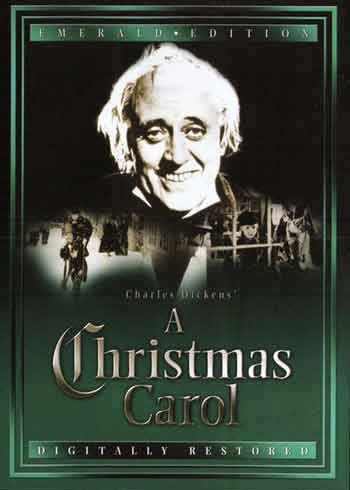


Directed by Brian Desmond Hurst. Starring Alaistar Sim. Released 1951.
Directed by Brian Desmond Hurst. Starring Alastair Sim. Released 1951. 86 minutes. Sim is the quintessential Ebenezer Scrooge, making all other attempts pale by comparison. Patrick MacNee (Steed in The Avengers) made his screen debut as the young Jacob Marley.
Scrooge starts of as, eh, well you know, Scrooge: "It's all humbug I tell you. All humbug." After thinking about his past and present and realizing how he became the person he is, and looking forward to his future, he decides to change.
Scrooge's Christmas-morning ecstasy is a marvel of giddy technique. "I am as light as a feather, I am as happy as an angel, I am as merry as a school-boy. I am as giddy as a drunken man. ... A merry Christmas, Ebenezer! You old humbug. ... I must, I must stand on my head.".
Tiny Tim: "God bless us, every one!"
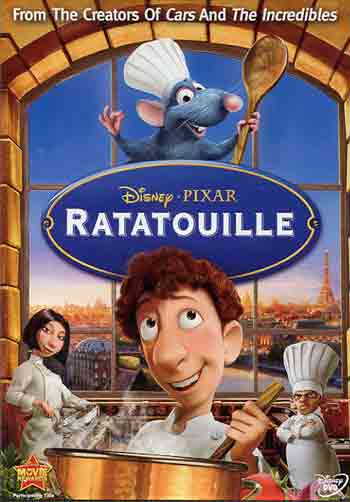
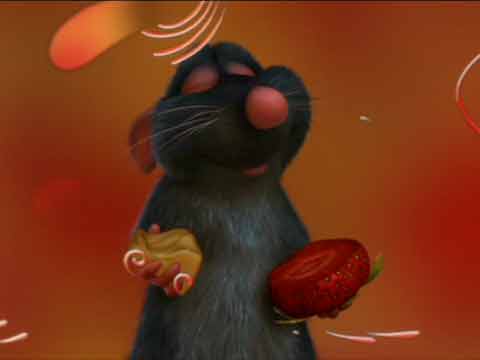

Directed by Brad Bird. Released 2007. 111 minutes.
Patton Oswalt plays Rémy, a country rat who winds up in Paris where he abandons his poison-checking occupation to fulfill his lifelong dream of cooking in a formely-great French restaurant. Ian Holm plays Skinner, the Napoleon-esque owner of "Gusteau's" and the main antagonist of the film. He sells out Gusteau's image to market TV dinners and tries to undermine Linguini's abnormal success. Lou Romano plays Alfredo Linguini, a garbage boy who becomes a famous chef when Rémy takes the helm of his arm control nerve. However, he lets the success go to his head and strikes up a relationship with Colette despite her curt behavior towards him. Peter O'Toole plays Anton Ego, a feared and loathed food critic who seems to delight in driving unexpecting chefs to heart attacks if they don't meet his lofty expectations.
When Remy’s dad says, “You can’t change nature.” Remy enlightens us on impermanence with, "Change is nature, Dad, the part that we can influence. And it starts when we decide." Remy, in learning to cook, has discovered that change is of the essence. It is the new combination of ingredients that brings out flavors unknown and exciting. And change will bring human and rat together
Ratatouille is charming and delightfully funny, yet also challenging and insightful. The obvious Buddhist overtones include a perfect depiction of Thich Nhat Hanh's mindful eating. Anton Ego is the essence of Ego gone crazy, but overcomes his ways by going back to the simplicity of his youth.
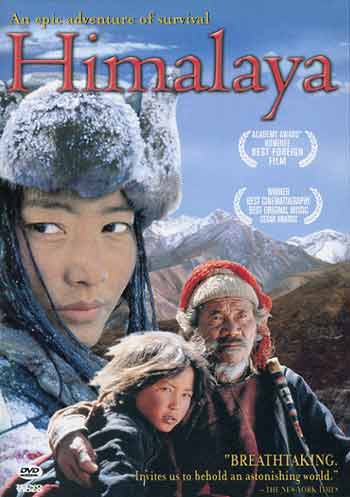


Directed by Eric Valli. Starring local Dolpo people. Released 1999. Filmed in Dolpo, Nepal. Nominated for Best Foreign Film at the Academy Awards.
Directed by Eric Valli. Starring local Dolpo people. Released 1999. 108 minutes. Nominated for Best Foreign Language Film Oscar in 2000. Filmed in Nepal's Dolpo region.
This movie is based on a true story and could even be considered a documentary, depicting the life style and customs of the Nepalese Dolpo people of Tibetan descent. When his son dies returning from Tibet's salt lakes, the village chief blames his son's friend and refuses to give him his blessing as the new chief. The scenery is stunning, taking place in the autumn and winter of the high Tibetan valleys, plateaus, gorges, deserts, and mountain lakes.
"When you see the snowstorm, it is a real snowstorm. It was in front of the camera and behind the camera. For nine months, we were on the trail of the real caravan. What you see on the screen is what we also experienced as filmmakers." - Eric Valli.
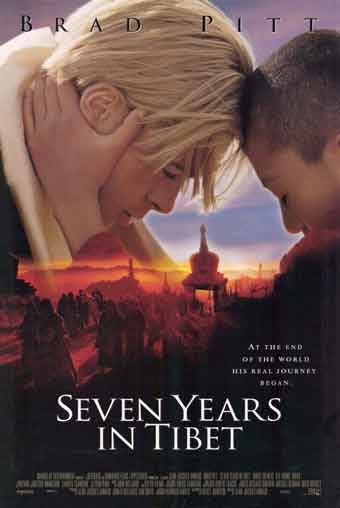
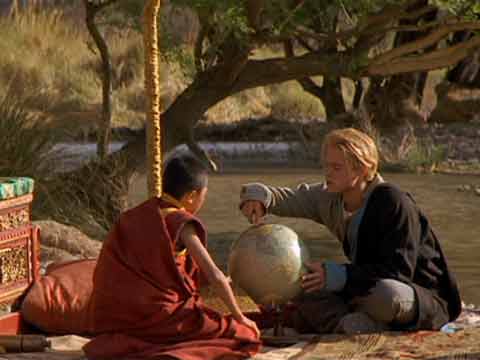

Directed by Jean-Jacques Annaud. Starring Brad Pitt and David Thewlis. Released 1997. 139 minutes. Filmed in British Columbia, Argentina, Austria, Chile, and Tibet.
Although many people were disappointed that Brad Pitt starred in this film, it is quite probable that the lavish $70 million film would not have been made without him.
The movie is an adaptation of the book, telling the story of Austrian Heinrich Harrer and Peter Aufschnaiter's escape from a British POW camp in India and their travels to Lhasa. Harrer stayed in Tibet for, eh, seven years, and met and tutored the young 14th Dalai Lama. I especially like the scenes where Harrer is building a movie theatre and must have all the worms carried one by away from the digging because all life is sacred. For an authentic touch, the film has the Dalai Lama's sister Jetsun Pema playing the role of their mother Amala.